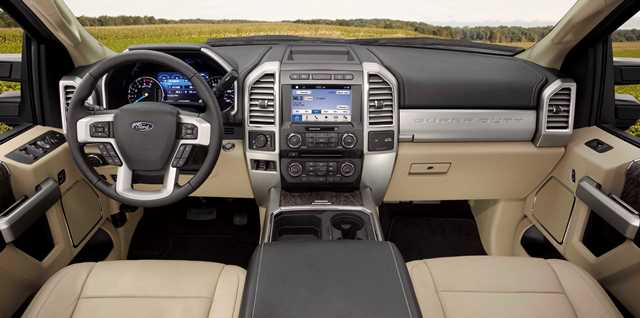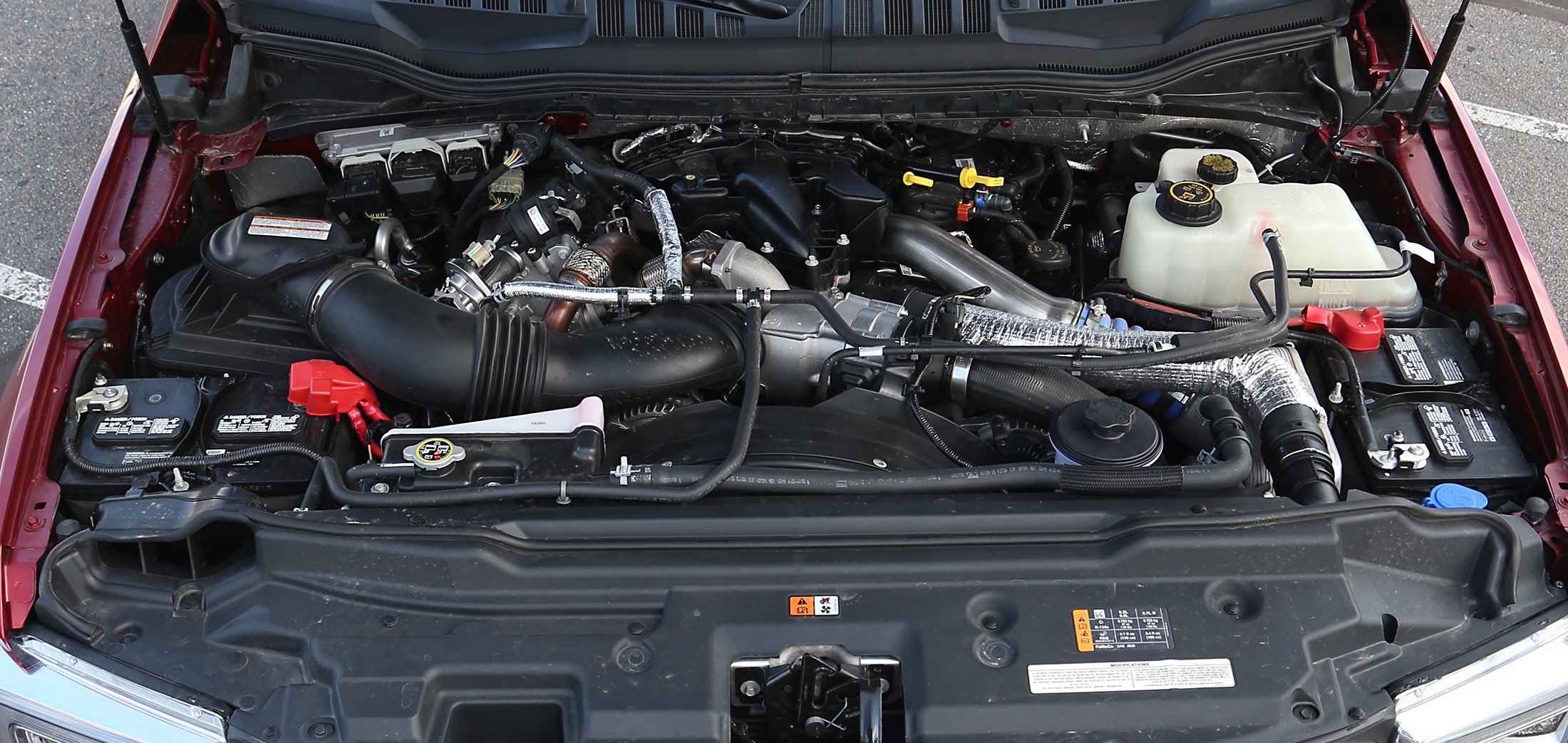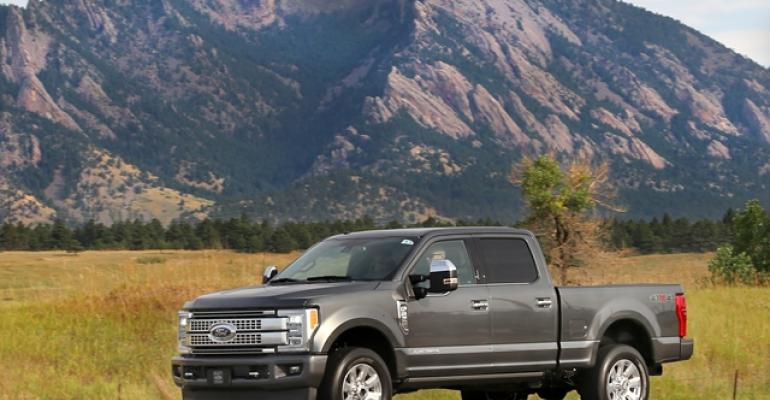DENVER, CO – A majority of customers for Ford’s heavy-duty pickups say they value quiet, composed performance in their beefy diesel trucks, and Ford is responding in a big way with its all-new ’17 F-Series Super Duty.
In the 6.7L V-8 diesel-powered F-250, for instance, engine noise barely infiltrates the cabin even though the engine delivers more power than the previous model and the truck’s cab now is made of aluminum instead of steel.
Ford’s heavy-duty lineup saw its last total makeover 18 years ago when the original Super Duty was introduced, so there’s obvious improvement in the new model. But the upgrades run far beyond what the eye can see, says Doug Scott, Ford truck marketing manager.
“There is more change here to Super Duty than there was for the F-150,” Scott says at a press drive here in the Colorado foothills.
Following the path blazed by its light-duty F-150 sibling, the ’17 Super Duty replaces steel body panels with lighter-weight aluminum for the cab and truck bed. Use of aluminum saves up to 350 lbs. (159 kg), depending on model. Ford employs the same 0.055-in. (1.4-mm) gauge “military-grade” aluminum as it uses on the light-duty F-150 body panels, but increases the bed thickness to 0.063 in. (1.6 mm).
Scott says the weight trimming attributed to the alternative metal actually is considerably greater than 350 lbs., but engineers plowed a lot of that savings into refinements and chassis upgrades that make the truck quieter and more capable compared with its predecessor.
Starting with the chassis, the truck uses 95% high-strength-steel for the fully boxed frame (vs. C-channel in the old truck), up from 15% in the outgoing model. The midframe rails are 1.5 ins. (38 mm) taller and the frame is braced with up to 10 crossmembers (depending on model), five of which are through-frame crossmembers. The improvements make the frame 24 times stiffer, Ford says.
The Super Duty also gets a beefier all-wheel-drive transfer case and driveline components, axles and towing hardware.
Taken together, the chassis upgrades give the Super Duty towing capability that is weight-carrying and weight-distributing without any of the usual added towing hardware to balance and stabilize a heavy trailer.
The F-250 pulls 15,000 lbs. (6,804 kg) and up to 18,000 lbs. (8,165 kg) when equipped with a trailer-towing package, as does the F-350 in single-rear-wheel configuration (21,000 lbs. [9,525 kg] with dual rear wheels). Maximum payloads are 4,200 lbs. (1,905 kg) for F-250 and 7,630 lbs. (3,461 kg) for F-350 (up from 7,050 lb. [3,198 kg]).
For those with super-heavy trailers, gooseneck towing capacity for an F-450 tops out at 32,500 lbs. (14,742 kg), up from 31,200 lbs. (14,152 kg), while maximum fifth-wheel towing is 27,500 lbs. (12,474 kg).
Aside from the chassis, the biggest improvements come in the cab, which now is shared across the F-Series lineup from light-duty pickups to the big chassis cabs. Super Duty models also see upgrades that already are migrating to the entire F-Series lineup.

One example is the addition of a sound-deadening rubber gasket at the base of the windshield that helps seal out engine noise – a running change now being applied to every F-Series cab, says Scott Paddy, powertrain engineer.
Another Super Duty cab update likely to appear on future light-duty trucks is lockable storage under the Crew Cab rear seats. The storage bins flip up into place and the seats lock down to keep valuables secure.
Unique to the Super Duty line are dual gloveboxes, a more usable center console made possible by the Super Duty column shifter, a unique instrument cluster, overhead auxiliary switches and a trailer brake controller.
Carryover Power, Upgraded and Down-Speeded
Powertrains largely are carryover, but Ford promises more power and efficiency from each drivetrain. They include two gasoline engines, a 6.2L V-8 and a 6.8L V-10, and the second-generation 6.7L Power Stroke V-8 turbodiesel. Transmissions all are 6-speed automatics.
The diesel now makes 440 hp and 925 lb.-ft. (1,254 Nm) of torque; horsepower is unchanged but torque is up 65 lb.-ft. (88 Nm) from ’16.
Paddy says special attention went into quieting the diesel, using dual-pilot fuel injection. Pilot injection helps heat up the combustion chamber by injecting small quantities of fuel before the main injection. The fuel burns as it is injected and combustion is spread out and quieter as a result, Ford says.
Although dual-pilot injection can result in increased fuel consumption, Ford engineers extensively optimized to both reduce noise and decrease overall fuel consumption.
“We go through a lot of effort to suppress and reduce that diesel clatter,” Paddy says. “We can’t eliminate it because it’s a diesel, but we can minimize it through engine calibration.”
Ford says fuel economy improves – they don’t specify how much and heavy-duty trucks don’t list an EPA fuel-economy number – but an upgrade to a 48-gallon fuel tank (from 36 gallons) gives the truck a 1,000-mi. (1,609-km) range.
Scott points out the tank change to all long-wheelbase Crew Cab models makes the truck more productive by reducing the amount of time and effort required for extra fuel stops with the smaller tank.

The V-8 gasoline engine produces 385 hp and 430 lb.-ft. (583 Nm) of torque, up 25 lb.-ft. (34 Nm). The V-10 for chassis-cab F-450/F-550 models makes 288 hp and 424 lb.-ft. (575 Nm) of torque, down from last year, but the engine is “down-speeded” with revised gearing in the 6-speed transmission. The change helped Ford meet EPA carbon-dioxide emissions regulations for heavy-duty pickups, the only manufacturer able to make that claim for a V-10 engine. Both gas engines are available with a CNG/Propane fuel prep kit.
Technology abounds in the Super Duty, with much of it focused on easier and safer towing and hauling. The Super Duty gets seven cameras to provide a 360-degree bird’s-eye view and new features such as Trailer Reverse Guidance, trailer tire-pressure monitoring, a driver-placed remote trailer camera and blindspot detection adjustable for trailers up to 33 ft. (10 m) long and 9 ft. (2.7 m) wide.
The new truck also gets Sync3, adaptive steering, active forward-collision braking assistance, lane-departure warning, adaptive cruise control with exhaust braking and a remote locking and releasing tailgate, the latter especially handy when backing up to hitch a big fifth-wheel trailer to the in-bed gooseneck.
We don’t drive heavy-duty pickups on a regular basis, but we found the big rigs surprisingly easy to handle, whether on local streets or out on the highway, when empty, pulling a heavy trailer or carrying a big payload. The diesel engine is particularly powerful, responsive and surprisingly quiet.
Especially impressive is adaptive cruise control that uses engine braking on diesel models, along with vehicle and trailer brakes and transmission gearing, to adjust speed to traffic flow down to 12 mph (20 km/h).
Optional adaptive steering, using a computer-controlled electric motor in the center of the steering wheel, reduces steering input required at low speeds while subtracting from driver input at higher speeds to maintain stability. A trailer-towing mode is particularly effective at minimizing steering action at speed to keep trailer sway in check.
Super Duty comes in five trim levels: XL, XLT, Lariat, King Ranch and Platinum (F-150 adds one more step, Limited); three cab configurations, Regular, Super Cab and Crew Cab; and two box lengths, 6.5 (2 m) and 8 ft. (2.4 m), except chassis cab.
The Super Duty, on sale now, is built at the Kentucky Truck Plant in Louisville, but Ford has added chassis-cab production capacity at its Ohio Assembly Plant in Avon Lake to meet Super Duty demand.
Prospective buyers will get a chance to drive the new Super Duty and test some of its trailering functions during a 29-city tour running through November. Consumers can schedule test drives at SuperDutyDrive.com.
[email protected] @bobgritzinger
'17 Ford F-250 Super Duty 4x4 Crew Cab Specifications
| Vehicle type | 5-passenger, 4-door heavy-duty pickup truck |
| Engine | 6.7L OHV turbocharged diesel V-8 |
| Power (SAE net) | 440 hp @ 2,800 rpm |
| Torque | 925 lb.-ft. (1,254 Nm) @ 1,800-2,000 rpm |
| Bore x stroke (mm) | 99 x 108 |
| Compression ratio | 16.2:1 |
| Transmission | 6-speed automatic |
| Wheelbase | 176 ins. (4,470 mm) |
| Overall length | 266 ins. (6,756 mm) |
| Overall width | 105.9 ins. (2,690 mm) |
| Overall height | 78 ins. (1,981 mm) |
| Curb weight | 7,494 lbs. (3,399 kg) |
| Base price | $57,655 (plus $1,195 destination charge) |
| Fuel economy | N/A |
| Competition | Chevrolet Silverado 2500, GMC Sierra 2500, Ram 2500 |
| Pros | Cons |
|---|---|
| Weight-saving aluminum comes to HD | Weight doesn’t matter in this class |
| Shared F-Series cab brings comfort, convenience | Durable interior priority in work trucks |
| Superb driver assistance systems | Nice electronics, but pricey |





